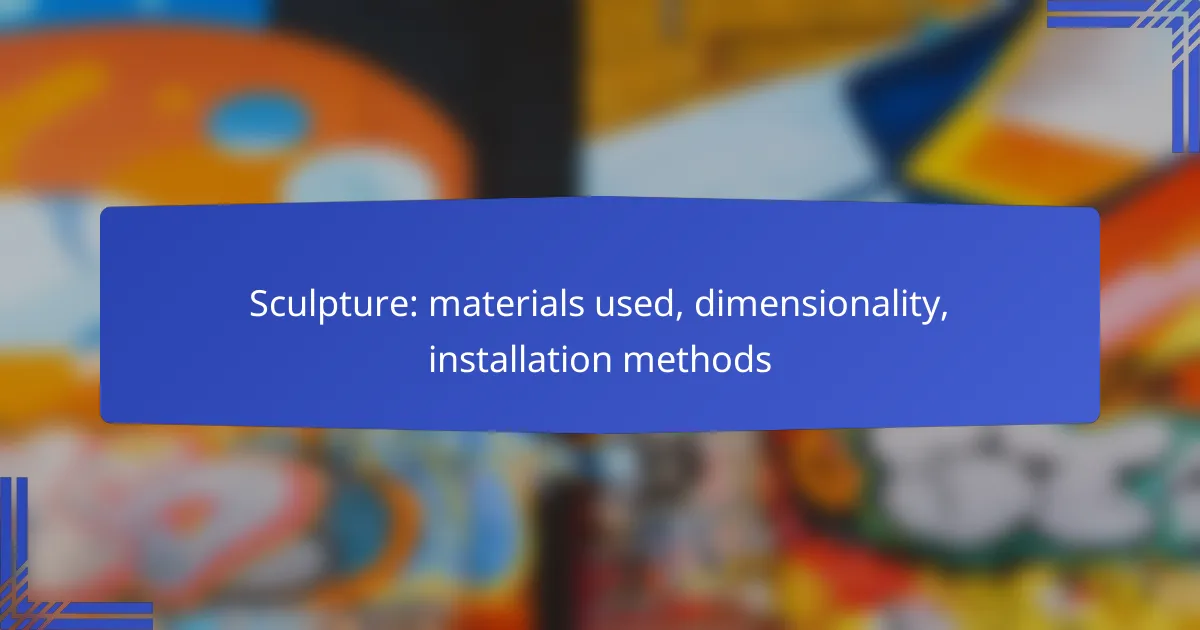Sculpture is a diverse art form that utilizes a range of materials such as bronze, marble, wood, clay, and glass, each contributing unique aesthetic qualities and influencing the sculpting process. The dimensionality of a sculpture plays a crucial role in its design, with three-dimensional works engaging viewers from multiple perspectives, while two-dimensional pieces rely on visual elements. Installation methods vary based on the artwork’s environment and material, ensuring stability, visibility, and safety for both indoor and outdoor displays.
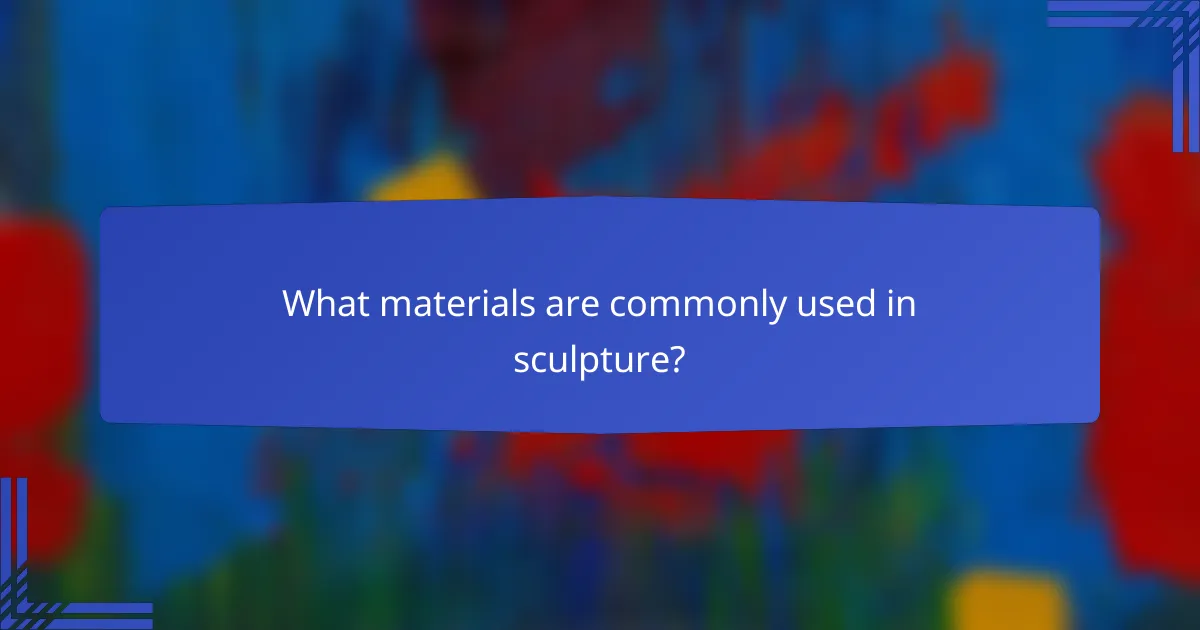
What materials are commonly used in sculpture?
Sculptors frequently use a variety of materials, each offering unique properties and aesthetic qualities. Common materials include bronze, marble, wood, clay, and glass, each with distinct characteristics that influence the sculpting process and final appearance.
Bronze
Bronze is a favored material in sculpture due to its durability and resistance to corrosion. It is an alloy primarily made of copper and tin, which can be cast into intricate shapes using techniques like lost-wax casting.
Artists appreciate bronze for its ability to capture fine details and its rich, warm color. Additionally, bronze sculptures can be finished with patinas to achieve various aesthetic effects.
Marble
Marble is renowned for its beauty and translucence, making it a classic choice for sculptures. This metamorphic rock is carved to create smooth, flowing forms and is often associated with classical art.
When working with marble, sculptors must consider its hardness, which requires specialized tools and techniques. The final product can range from polished, high-gloss finishes to more textured surfaces, depending on the artist’s vision.
Wood
Wood is a versatile and accessible material for sculptors, offering a range of textures and colors. Different types of wood, such as oak, cherry, or pine, can be used to create both intricate and large-scale sculptures.
Working with wood allows for easy manipulation and carving, but it also requires attention to grain patterns and potential warping. Artists often apply finishes to enhance the wood’s natural beauty and protect it from environmental damage.
Clay
Clay is a malleable material that is ideal for creating detailed sculptures and models. It can be easily shaped and reworked, making it a popular choice for both beginners and experienced artists.
Once sculpted, clay pieces are typically fired in a kiln to harden them, resulting in ceramic sculptures. Artists can experiment with various glazes and surface treatments to achieve different finishes and colors.
Glass
Glass is a unique and modern material used in sculpture, known for its transparency and light-reflecting qualities. Sculptors often use techniques like blowing, casting, or fusing to create intricate glass forms.
Working with glass requires specialized skills and equipment, as it involves high temperatures and precise handling. The resulting sculptures can range from delicate, ethereal pieces to bold, colorful installations that interact with light in captivating ways.
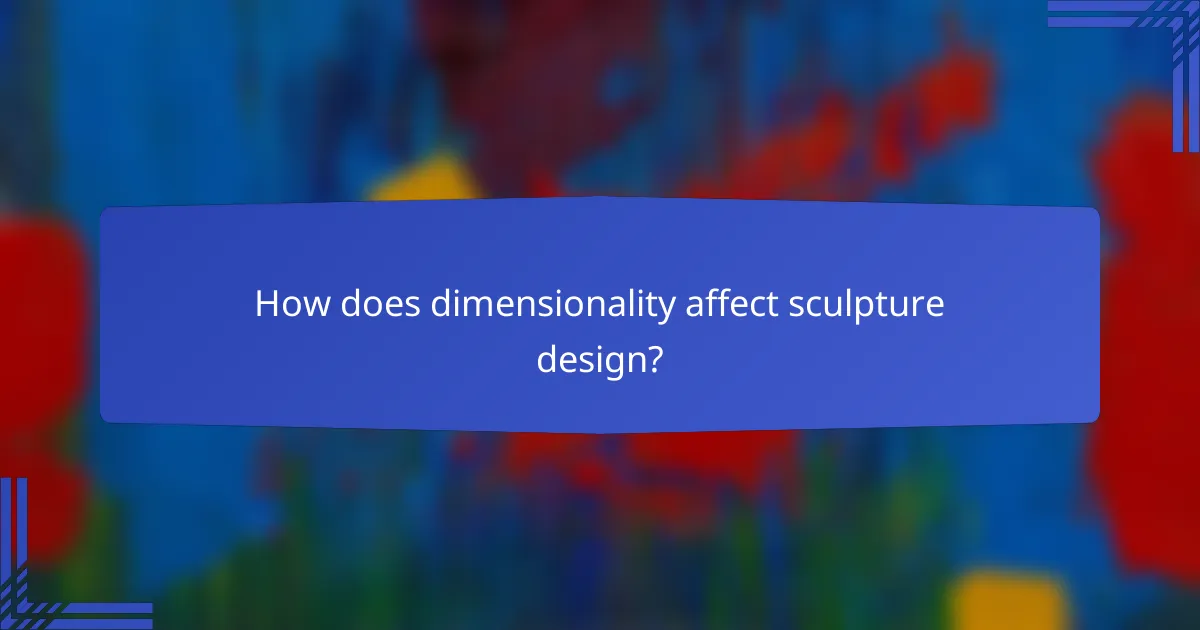
How does dimensionality affect sculpture design?
Dimensionality significantly influences sculpture design by determining the form, perspective, and viewer interaction. Two-dimensional sculptures are typically flat and rely on visual elements, while three-dimensional sculptures engage viewers from multiple angles and require consideration of space and volume.
Two-dimensional sculptures
Two-dimensional sculptures, often referred to as reliefs or wall sculptures, are primarily flat and can be made from materials like wood, metal, or paper. They are designed to be viewed from one side, emphasizing visual composition and texture over physical depth.
Common examples include bas-reliefs and cut-out designs, which can be mounted on walls or displayed in frames. When creating two-dimensional sculptures, artists should focus on balance, color contrast, and the interplay of light and shadow to enhance visual impact.
Three-dimensional sculptures
Three-dimensional sculptures occupy physical space and can be viewed from all angles, making them more immersive. Materials such as stone, clay, metal, and glass are frequently used, allowing for a wide range of textures and finishes.
Artists must consider factors like weight distribution, structural integrity, and the surrounding environment during the design process. For instance, large outdoor sculptures may require a sturdy base and weather-resistant materials, while smaller indoor pieces can explore intricate details and delicate forms.
Installation considerations
Installation is a critical aspect of sculpture design, particularly for three-dimensional works. Factors such as location, lighting, and viewer accessibility must be taken into account to ensure the sculpture is effectively showcased.
When installing a sculpture, consider the surrounding space and how it interacts with the piece. Ensure that there is enough room for viewers to walk around and appreciate the work from different angles. Additionally, securing the sculpture properly is essential to prevent accidents, especially in public spaces.

What are the methods for installing sculptures?
Installing sculptures involves various techniques tailored to the environment and material of the artwork. Key methods include outdoor and indoor installations, each requiring specific considerations for stability, visibility, and safety.
Outdoor installation techniques
Outdoor installations often require robust methods to withstand weather conditions and environmental factors. Common techniques include anchoring sculptures to concrete bases, using ground stakes, or employing heavy-duty mounting brackets. It’s essential to consider local regulations regarding public art installations, which may dictate specific requirements for safety and durability.
For example, sculptures in public parks may need to be secured against vandalism and extreme weather, while those in private gardens can be more flexible. Always assess the site for soil conditions and drainage to ensure long-term stability.
Indoor installation techniques
Indoor installations typically focus on aesthetics and spatial dynamics. Techniques can range from freestanding sculptures to those mounted on walls or pedestals. When installing indoors, consider the weight of the sculpture and the structural integrity of the floor or wall where it will be placed.
Using appropriate supports, such as brackets or hidden mounts, can enhance the visual appeal while ensuring safety. Additionally, lighting plays a crucial role in indoor installations, as it can dramatically affect the sculpture’s perception and ambiance.
Mounting options
Mounting options vary based on the sculpture’s material and intended location. Common methods include direct mounting to a base, using wall brackets, or employing a pedestal for elevation. For heavier sculptures, consider using reinforced mounts that can bear significant weight without compromising safety.
When selecting mounting options, evaluate the sculpture’s balance and how it interacts with its surroundings. For instance, a tall sculpture may require a wider base to prevent tipping, while smaller pieces might benefit from minimalist mounts that emphasize their design.
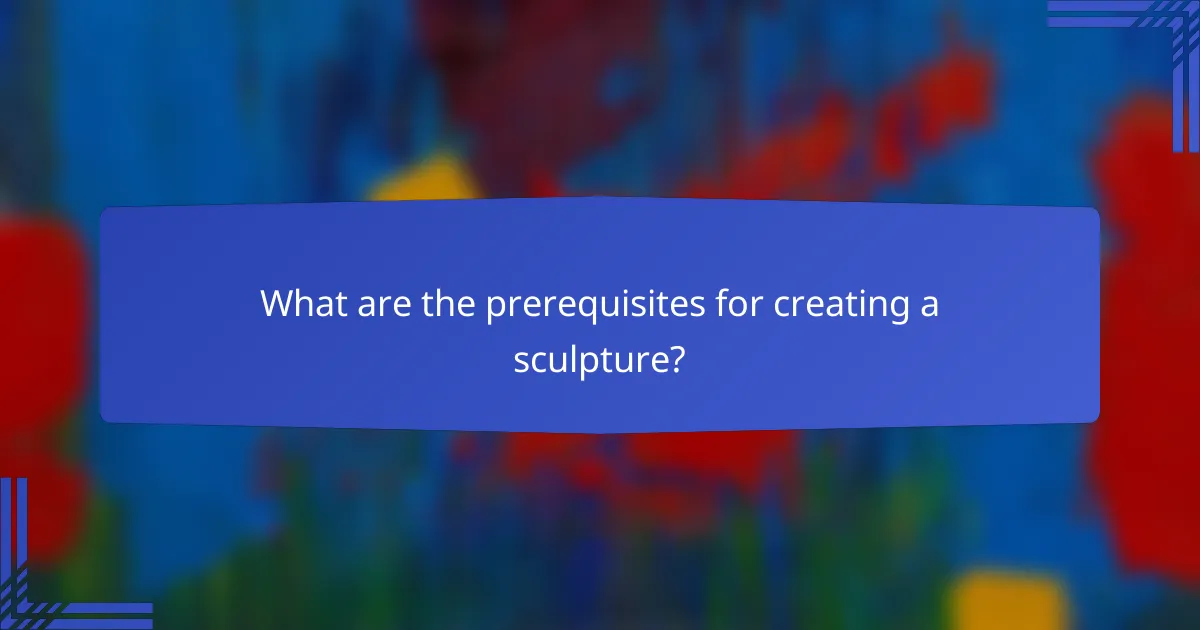
What are the prerequisites for creating a sculpture?
Creating a sculpture requires a solid understanding of materials, design planning, and installation methods. These prerequisites ensure that the final piece is not only aesthetically pleasing but also structurally sound and appropriate for its intended location.
Understanding materials
Choosing the right materials is crucial in sculpture creation. Common materials include clay, stone, metal, wood, and glass, each offering unique properties and aesthetic qualities. For instance, clay is versatile and easy to manipulate, while stone provides durability and permanence.
Consider the environment where the sculpture will be displayed. Outdoor sculptures may require weather-resistant materials like bronze or treated wood, while indoor pieces can utilize more delicate options like glass or plaster. Understanding the characteristics of each material will help in making informed decisions.
Design planning
Effective design planning involves sketching ideas, considering dimensions, and determining the sculpture’s final placement. Artists should create scale models or digital renderings to visualize the piece and assess its proportions. This step helps identify potential issues before the actual creation begins.
Additionally, consider the installation method during the design phase. Will the sculpture be freestanding, mounted, or suspended? Each method has different requirements for stability and support, which should be factored into the design to avoid complications during installation.
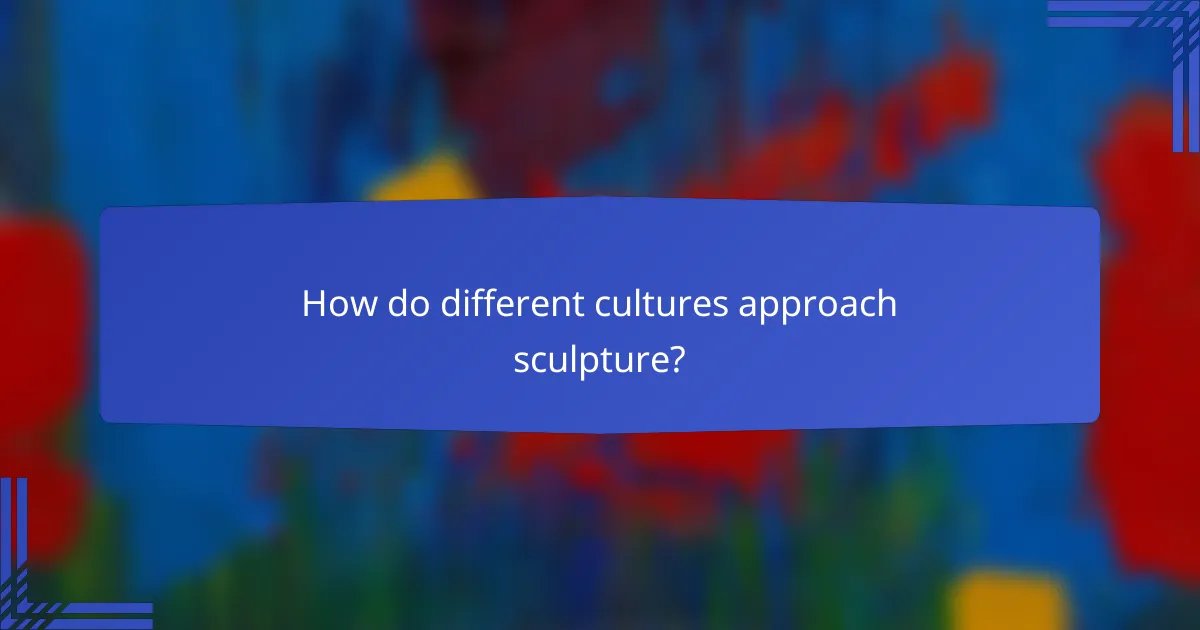
How do different cultures approach sculpture?
Different cultures approach sculpture through unique traditions, materials, and techniques that reflect their values and beliefs. These approaches can vary significantly, influencing how sculptures are created, perceived, and integrated into society.
Western sculpture traditions
Western sculpture has evolved from classical Greek and Roman influences to modern and contemporary styles. Traditionally, materials such as marble, bronze, and wood were favored, often emphasizing realism and human form. Techniques like carving and casting are prevalent, with a strong focus on proportion and perspective.
In the 20th century, movements like Abstract Expressionism and Minimalism shifted the focus from representational forms to conceptual ideas. Artists began to experiment with unconventional materials, including plastics and found objects, leading to a broader definition of what sculpture can be.
Eastern sculpture traditions
Eastern sculpture traditions, particularly in countries like India, China, and Japan, often emphasize spiritual and symbolic meanings. Materials such as stone, clay, and metal are commonly used, with intricate details that reflect cultural narratives and religious themes. For instance, Buddhist sculptures often depict deities and are crafted to inspire meditation.
In many Eastern cultures, the process of creation is as important as the final product. Techniques may include hand-carving and casting, with a focus on harmony and balance that aligns with philosophical beliefs. This approach often results in sculptures that are integrated into natural landscapes or architectural settings.
Contemporary practices
Contemporary sculpture practices are characterized by a diverse range of materials and techniques, reflecting global influences and technological advancements. Artists today often blend traditional methods with modern technologies, such as 3D printing and digital fabrication, allowing for innovative forms and structures.
Installation art has become a significant aspect of contemporary sculpture, where the environment plays a crucial role in the experience. Artists may create site-specific works that interact with their surroundings, challenging viewers to engage with the space in new ways. This trend emphasizes the relationship between sculpture and its context, making the viewer’s experience central to the artwork.
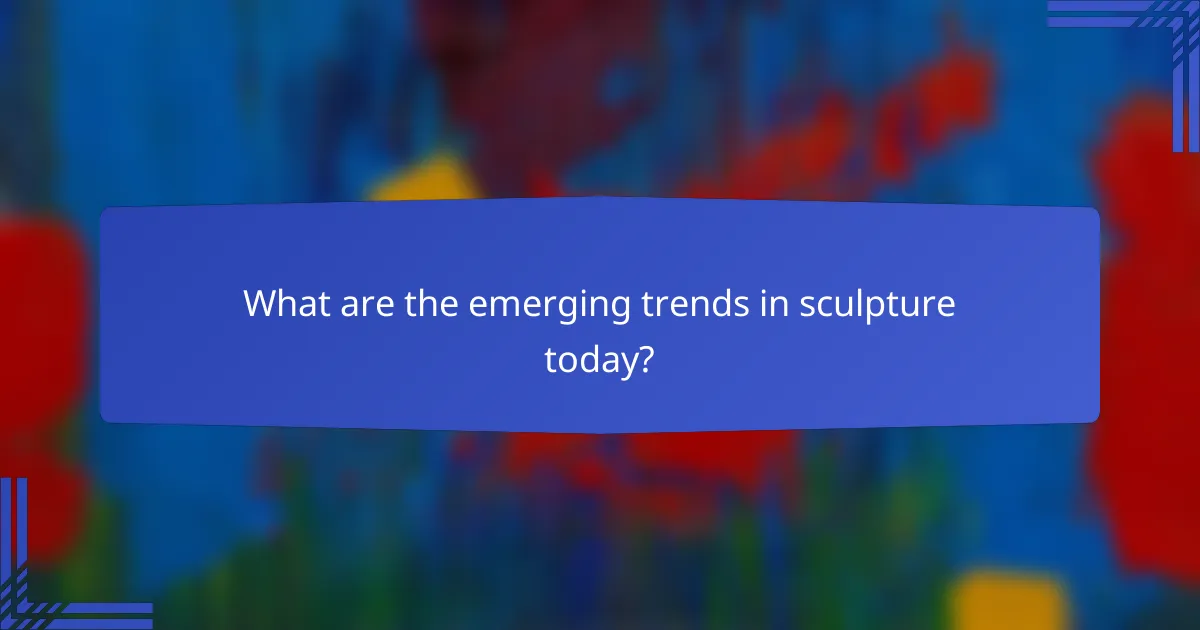
What are the emerging trends in sculpture today?
Emerging trends in sculpture today include the use of innovative materials, interactive installations, and a focus on sustainability. Artists are increasingly experimenting with technology and mixed media to create immersive experiences that engage viewers in new ways.
Materials used in contemporary sculpture
Contemporary sculpture often incorporates a diverse range of materials, including traditional options like stone and metal, as well as modern choices such as plastics, glass, and recycled materials. This variety allows artists to explore different textures and forms, enhancing the visual and tactile experience of their work.
Additionally, the use of digital fabrication techniques, such as 3D printing, is becoming more prevalent. These methods enable the creation of complex shapes and designs that would be difficult or impossible to achieve by hand.
Dimensionality in sculpture
Dimensionality in sculpture refers to the physical space that a piece occupies and how it interacts with its surroundings. Artists are increasingly creating works that challenge traditional notions of three-dimensionality by incorporating elements of light, shadow, and movement.
For instance, some sculptures are designed to be viewed from multiple angles, encouraging viewers to walk around and engage with the piece. Others may include kinetic components that change shape or position, adding a dynamic quality to the artwork.
Installation methods for sculptures
Installation methods for sculptures vary widely depending on the material and design of the piece. Common techniques include mounting on pedestals, wall installations, or integrating sculptures into natural landscapes. Each method requires careful consideration of stability, visibility, and interaction with the environment.
When installing large outdoor sculptures, artists often collaborate with engineers to ensure safety and durability. It’s essential to consider factors such as weather conditions, local regulations, and the potential impact on the surrounding area.
